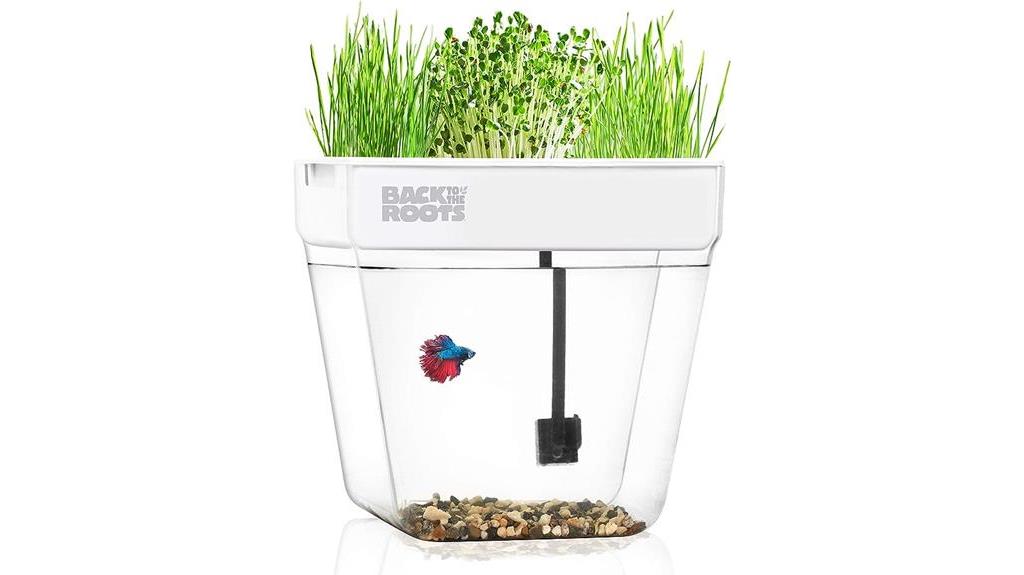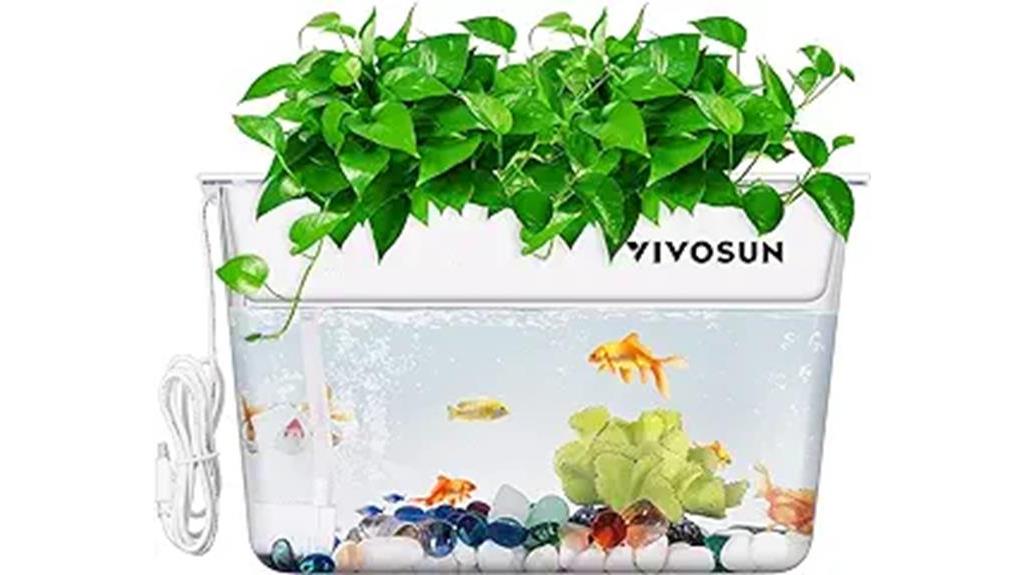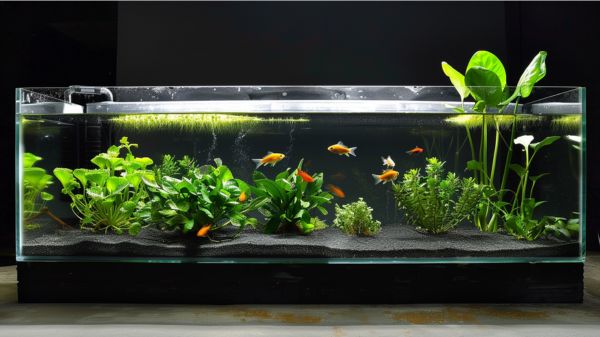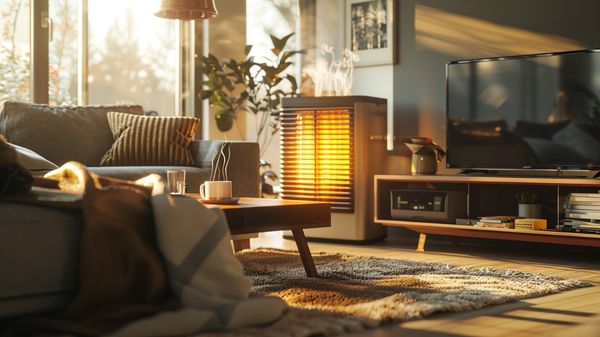Step into the world of aquaponics where your aquarium transforms into a bustling ecosystem. Curious to have your own mini underwater world? Discover the best aquaponics indoor aquarium that not only house your fish but also support lush plant growth.
From self-watering planters to desktop kits, these setups offer a glimpse into sustainable living. Explore how these aquaponic systems can revolutionize your indoor space and provide a harmonious environment for both flora and fauna.

Back to the Roots Indoor Aquaponic Garden – Self Watering Planter with Fishtank

For those seeking a self-sustaining indoor aquaponic garden that combines a fish tank with plant cultivation, the Back to the Roots Indoor Aquaponic Garden offers a convenient and educational solution.
This indoor aquaponic system allows year-round growth of succulents, herbs, microgreens, bamboo, and houseplants in a compact 3-gallon capacity.
The self-cleaning fish tank fertilizes plants with fish waste while maintaining a clean aquatic ecosystem. Setting up the water garden is a breeze with included step-by-step instructions, and the kit even provides seeds, water conditioner, growing medium, fish food, and a fish coupon.
Users appreciate the low maintenance and educational value of the system, making it an enjoyable way to learn about aquaponics while enjoying the benefits of fresh homegrown produce.
Best For: Those looking for a hands-on educational experience in aquaponics and indoor gardening.
Pros:
- Easy setup with step-by-step instructions.
- Self-cleaning fish tank that fertilizes plants.
- Year-round growth of various plants in a compact space.
Cons:
- Requires regular maintenance like weekly water changes.
AquaSprouts Garden Desktop Aquaponics Ecosystem Kit

Ideal for individuals seeking a self-sustaining aquaponics system that promotes plant growth and fish health, the AquaSprouts Garden Desktop Aquaponics Ecosystem Kit offers a compact and efficient solution for home or office environments.
This kit allows fish to fertilize plants, which in turn clean the water for the fish, reducing the need for frequent water changes and filter replacements. You can grow veggies, herbs, and greens year-round without the use of additional fertilizers.
Designed to fit standard 10-gallon aquariums, approximately 20 X 10 X 12 inches in size, this ecosystem serves as a great tool for exploring natural environments and is perfect for those with limited space. Additional equipment like an undergravel filter, LED light, heater, air pump, and grow light are required for setup and maintenance.
Best For: Individuals looking to explore aquaponics with limited space and seeking a self-sustaining ecosystem for home or office use.
Pros:
- Self-sustaining aquaponics system promoting plant growth and fish health.
- Reduction in maintenance with fish fertilizing plants and plants cleaning water.
- Year-round growth of veggies, herbs, and greens without additional fertilizers.
Cons:
- Requires additional equipment for setup and maintenance.
VIVOSUN 3-Gallon Aquaponic Fish Tank with Additional Accessories

With its self-cleaning function and compatibility with over 150 types of plants, the VIVOSUN 3-Gallon Aquaponic Fish Tank is a versatile choice for aquaponics enthusiasts looking to create a thriving ecosystem at home.
This aquaponic system features a symbiosis of fish, vegetables, and microbes that benefit each other. Equipped with a siphon oxygen supply and thermostat for best plant growth and fish well-being, it also includes a self-cleaning function that naturally cleans the water.
The value pack comes with the fish tank, accessories, and an additional thermostat. While users have faced challenges such as feeding accessibility, siphon fitting, and noise levels, they appreciate the compatibility with Betta fish, plant growth, and water quality improvements.
Best For: Those seeking a versatile aquaponic system with self-cleaning function and compatibility with a wide variety of plants.
Pros:
- Compatibility with over 150 types of plants.
- Siphon oxygen supply and thermostat for optimal plant growth.
- Self-cleaning function for natural water cleaning.
Cons:
- Issues with clay balls and pump design.
Factors to Consider When Choosing an Aquaponics Indoor Aquarium
When choosing an aquaponics indoor aquarium, remember to take into account the size for your space, the types of plants you want to grow, and the maintenance it will require.
Make sure the equipment you have is compatible with the aquarium system you choose, and make the most of your indoor space by optimizing its utilization.
Related Post: The Best Indoor Aquaponics Kit: Top 10 Winners for Growing Plants & Fish at Home.
Size Considerations
When choosing an aquaponics indoor aquarium, one important factor to take into account is the available space in your home or office.
The size of the aquarium will determine the number and size of fish and plants you can accommodate in the ecosystem. Larger aquariums provide more stability in water parameters and allow for a diverse range of plant and fish species.
On the other hand, smaller aquaponics systems are suitable for beginners or those with limited space, requiring less maintenance and initial setup costs. It’s vital to make sure that the size of the aquaponics indoor aquarium is proportional to your intended use and level of experience to create a successful mini ecosystem.
Plant Variety
To guarantee the success of your aquaponics indoor aquarium, carefully consider the plant variety you intend to grow, taking into account factors like nutrient requirements and growth habits. Different plants, such as herbs, vegetables, or decorative plants, have specific compatibility with aquaponic systems.
Some systems are better suited for certain varieties like leafy greens, while others can accommodate a wider range of plants, including fruiting crops. The plant variety you choose will impact the nutrient needs, water quality, and overall maintenance of your indoor aquaponic system.
Consider the growth rates and root structures of your selected plants, as they can influence the design and setup of your aquaponic garden. Understanding the light requirements and nutrient preferences of your chosen plant varieties is important for successful cultivation in an indoor aquaponic setup.
Maintenance Needs
Regularly maintaining your aquaponics indoor aquarium is essential for the health and sustainability of your ecosystem. Tasks such as monitoring water quality, feeding fish, and pruning plants are important for a thriving mini ecosystem.
Testing water parameters like pH levels, ammonia, nitrites, and nitrates is necessary to maintain a balanced environment. Cleaning the tank, removing debris, and performing water changes help prevent algae growth and maintain oxygen levels.
Inspection of equipment such as pumps, filters, and heaters is crucial to prevent potential malfunctions that could harm your aquatic life.
By following a maintenance schedule and observing fish and plant behavior closely, you can detect any issues early and address them promptly, ensuring the well-being of your aquaponics indoor aquarium.
Equipment Compatibility
Choosing an aquaponics indoor aquarium that’s compatible with essential equipment and various plant and fish types is important for creating a thriving ecosystem. Make sure the system fits standard aquarium sizes like 10-gallon tanks for easy setup.
Check compatibility with LED lights, heaters, air pumps, and grow lights to support plant growth and fish health. Consider the system’s ability to grow a variety of plants, including vegetables, herbs, and greens, for diverse cultivation options.
Look for compatibility with different types of fish to establish a balanced ecosystem benefiting both plants and fish. Also, make sure compatibility with additional accessories such as filters, thermostats, and oxygen supply systems to maintain water quality and system efficiency.
Space Utilization
Consider the space available and the dimensions of your indoor area when selecting an aquaponics indoor aquarium. Utilizing vertical space with aquaponics systems allows for efficient use of limited indoor space.
Compact designs like desktop aquaponics kits are ideal for small apartments, offices, or classrooms. When choosing a system, consider the footprint and height to make sure it fits in the desired indoor location. Opt for systems with built-in features like self-cleaning functions to maximize space efficiency.
Customizable setups can be tailored to fit specific indoor spaces and design preferences. By being mindful of the space available and selecting a suitable aquaponics system, you can create a thriving mini ecosystem in your indoor environment.
Aesthetic Appeal
To enhance the visual appeal of your aquaponics indoor aquarium, focus on creating a harmonious blend between the fish tank, plants, and overall design. Incorporate live plants, colorful fish, and natural decor to elevate the beauty of your aquaponic setup.
Pay attention to vital lighting, plant arrangement, and tank accessories as they play an important role in creating an aesthetically pleasing environment. Choosing complementary colors, textures, and materials for the aquarium and plant containers can enhance the overall look of your setup.
Cost Efficiency
Enhancing the cost efficiency of your aquaponics indoor aquarium involves evaluating factors such as initial setup costs, long-term savings potentials, and energy consumption considerations.
Aquaponics systems can be cost-efficient due to the symbiotic relationship between fish and plants, reducing the need for additional fertilizers. The initial setup cost varies based on tank size, equipment needed, and plant-fish selection.
Long-term savings are achievable through reduced water usage, minimal maintenance needs, and homegrown produce. Evaluating factors like energy consumption for pumps, lights, and heaters is vital for overall cost efficiency.
Optimize cost efficiency by carefully planning, researching, and selecting appropriate equipment and plant-fish combinations.
Customization Options
When selecting an aquaponics indoor aquarium, explore the various customization options available to tailor the setup to your preferences and needs.
Customization options can include adding live plants, decorative elements, and extra accessories for aesthetic appeal. Some systems allow you to customize the plant selection, fish species, and overall layout to suit your personal preferences.
Additionally, adjusting the lighting, filtration system, and water flow can create the ideal environment for both fish and plants. For those more experienced, DIY customization is an option to enhance functionality or appearance.
Keep in mind that customization choices can affect the overall cost, maintenance requirements, and the success of your aquaponics system.
Frequently Asked Questions
How Often Do I Need to Clean the Fish Tank in an Aquaponics System?
You should clean the fish tank in your aquaponics system every 2-4 weeks. Regular maintenance helps keep the water quality best for your fish and plants, ensuring a healthy ecosystem. Don’t forget to remove any excess waste and debris during cleaning.
Can I Use Any Type of Fish in an Aquaponics System, or Are There Specific Species That Work Best?
You can use various fish in an aquaponics system, but some species like tilapia and trout are commonly recommended for their adaptability and growth rate. Make sure to choose fish that thrive in the system’s environment for success.
How Long Does It Take for Plants to Grow in an Aquaponics System Compared to Traditional Gardening Methods?
In an aquaponics system, plants typically grow faster compared to traditional gardening methods due to the nutrient-rich water they receive from the fish waste. You’ll notice quicker growth and healthier plants in this setup.
Are There Any Specific Water Temperature Requirements for the Fish in an Aquaponics System?
To keep your fish healthy in an aquaponics system, maintaining water temperatures between 75-80°F is crucial. This range supports best fish metabolism and overall well-being. Regular monitoring and adjustments will help create a thriving ecosystem.
Can I Use Tap Water in an Aquaponics System, or Do I Need to Use Filtered or Treated Water?
You can use tap water in an aquaponics system, but it’s recommended to treat it first to remove chlorine and other chemicals. Filtering the water or using a dechlorinator will help guarantee a healthy environment for your fish and plants.
Conclusion
To sum up, creating your own mini ecosystem with an aquaponics indoor aquarium is a fun and rewarding experience. Whether you choose the Back to the Roots self-watering planter, the AquaSprouts desktop kit, or the VIVOSUN 3-gallon fish tank, you can enjoy the benefits of growing plants and keeping fish in a symbiotic environment.
Consider factors like size, maintenance, and additional accessories when selecting the best aquaponics system for your home. Immerse yourself in the world of aquaponics and watch your mini ecosystem thrive!





